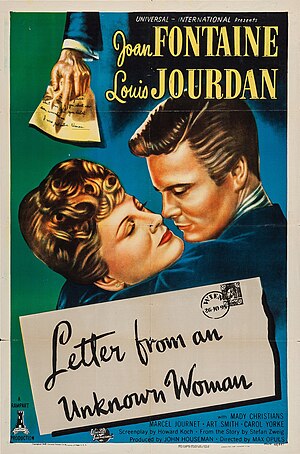Letter from an Unknown Woman (1948 film)
Jump to navigation
Jump to search
| This article was copied (instead of imported) from the now-deleted Miraheze wikis. |
| Letter from an Unknown Woman (1948 film) | ||||||||||||||||||||||||||
|---|---|---|---|---|---|---|---|---|---|---|---|---|---|---|---|---|---|---|---|---|---|---|---|---|---|---|
This film has been preserved in the National Film Registry in 1992.
| ||||||||||||||||||||||||||
 | ||||||||||||||||||||||||||
|
Letter from an Unknown Woman is a 1948 American drama romance film released by Universal-International and directed by Max Ophüls (listed as Max Opuls in the opening credits sequence). It was based on the novella of the same name by Stefan Zweig. The film stars Joan Fontaine, Louis Jourdan, Mady Christians, and Marcel Journet.
Why It Rocks
- It's a bittersweet costume drama set in 1900 Vienna, and a lush skillfully-crafted tearjerker - of the bittersweet theme of unrequited, lost love. It's also considered a quintessential "woman's picture" for this very reason. Its cyclically-told tale of romantic yearning and pining for love was about an imaginary romance, embodied in the doomed, delusional (and illusory) relationship of the two romantic leads: a young neighbor girl's steadfast, sacrificial love for a self-absorbed, frivolous dilettante concert pianist. A seduction led to an unexpected pregnancy, and then to marriage to another. Both faced an inextricable impasse and experienced numerous missed opportunities over a span of twenty years - and ultimately failed to attain true romance. Back in the film was first released, it was deemed "too European" and "schmaltzy," the picture was a box-office failure in the United States, but thankfully it gained popularity through television in the ‘50s.
- The film's lead pair, Stefan and Lisa, are both very interesting and admirable characters.
- Stefan lives his selfish life without seeing anything. The director shows him as a handsome nice young man, but if you look carefully, you'll notice it's always Lisa (Fontaine) who's looking at him with love. Stefan seems to care but actually, he knows so many women that he acts as if he's in a play: Lisa's admiration means nothing to him who is a ladykiller - see the scene when Lisa comes back from the station- and a celebrated musician adulated by the crowds.
- Max Ophuls is notable for finding motives and strengths for his female characters that take them beyond the usual stereotypes commonly found in motion pictures back in the day, Lisa Berndle is no exception. She's not afraid to make her own choices throughout the film (leaving home for a job as a model; pursuing Jordan until he realizes he can have her; abandoning the husband who cares for her and who clearly loves her.) Unlike many soap opera heroines, she has a measure of control over her life.
- With the film told primarily in flashback through the night-time reading of the deathbed letter written by the dying female protagonist, a lot of Ophuls' stylistic trademarks are featured here such as fluid long takes, elaborate camera movement, opulent detail, and visual repetition.
- The pessimism, the sense that the best one can hope for is a few moments of fleeting happiness, was startling in Zweig's time and continues to be so today. It's rare that a movie forces its characters to confront the emptiness and loss that make up their lives.
- Impeccable performances of the film's delicate blonde heroine - portrayed by 31-year-old actress Joan Fontaine and the male lead Louis Jourdan. Fontaine's superb in what may be her best role ranging from love-smitten teen to conflicted mother. Jourdan's just as accomplished in a difficult role earning sympathy as disillusioned Lothario.
- Decent character development for Stefan. As the film progresses Fontaine's attraction to the artist begins to deepen and humanize the audience's response to him, as he begins to act less selfish towards her.
- The film was adapted from a 1922 short story (novella) by Stefan Zweig, and despite the film altering various aspects of the source material, the film adaptation continues to retain most of the novel's spirit and themes, even with the Hays Code forcing most of sexual moments to be toned down. In expanding the plot the male lead changed from a writer to a classical pianist, this enabled the composer to fill the score with lush, romantic musical themes.
Comments
Loading comments...